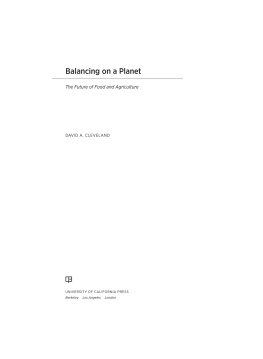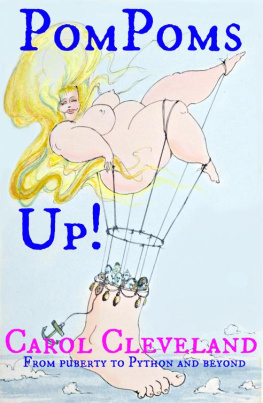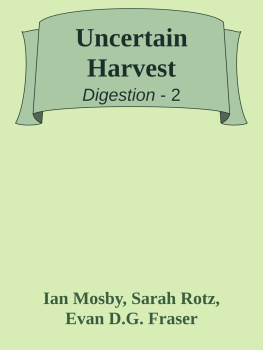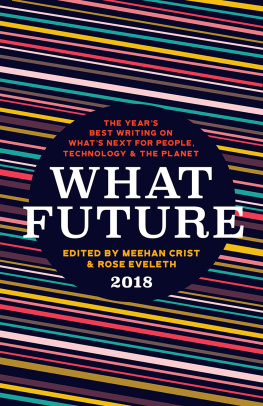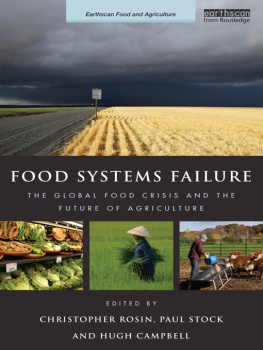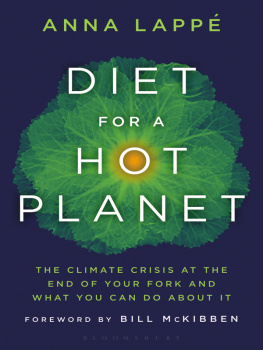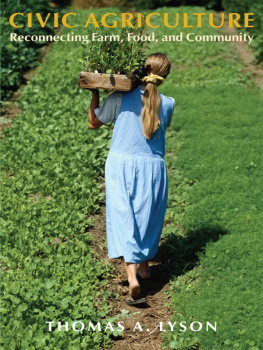Cleveland - Balancing on a planet: the future of food and agriculture
Here you can read online Cleveland - Balancing on a planet: the future of food and agriculture full text of the book (entire story) in english for free. Download pdf and epub, get meaning, cover and reviews about this ebook. City: Berkeley, year: 2016, publisher: University of California Press, genre: Politics. Description of the work, (preface) as well as reviews are available. Best literature library LitArk.com created for fans of good reading and offers a wide selection of genres:
Romance novel
Science fiction
Adventure
Detective
Science
History
Home and family
Prose
Art
Politics
Computer
Non-fiction
Religion
Business
Children
Humor
Choose a favorite category and find really read worthwhile books. Enjoy immersion in the world of imagination, feel the emotions of the characters or learn something new for yourself, make an fascinating discovery.
- Book:Balancing on a planet: the future of food and agriculture
- Author:
- Publisher:University of California Press
- Genre:
- Year:2016
- City:Berkeley
- Rating:5 / 5
- Favourites:Add to favourites
- Your mark:
- 100
- 1
- 2
- 3
- 4
- 5
Balancing on a planet: the future of food and agriculture: summary, description and annotation
We offer to read an annotation, description, summary or preface (depends on what the author of the book "Balancing on a planet: the future of food and agriculture" wrote himself). If you haven't found the necessary information about the book — write in the comments, we will try to find it.
Cleveland: author's other books
Who wrote Balancing on a planet: the future of food and agriculture? Find out the surname, the name of the author of the book and a list of all author's works by series.
Balancing on a planet: the future of food and agriculture — read online for free the complete book (whole text) full work
Below is the text of the book, divided by pages. System saving the place of the last page read, allows you to conveniently read the book "Balancing on a planet: the future of food and agriculture" online for free, without having to search again every time where you left off. Put a bookmark, and you can go to the page where you finished reading at any time.
Font size:
Interval:
Bookmark:

Balancing on a Planet
Balancing on a Planet
The Future of Food and Agriculture
DAVID A. CLEVELAND

UNIVERSITY OF CALIFORNIA PRESS
BerkeleyLos AngelesLondon
University of California Press, one of the most distinguished university presses in the United States, enriches lives around the world by advancing scholarship in the humanities, social sciences, and natural sciences. Its activities are supported by the UC Press Foundation and by philanthropic contributions from individuals and institutions. For more information, visit www.ucpress.edu.
University of California Press
Berkeley and Los Angeles, California
University of California Press, Ltd.
London, England
2014 by David A. Cleveland
Library of Congress Cataloging-in-Publication Data
Cleveland, David Arthur.
Balancing on a planet : the future of food and agriculture / David A. Cleveland.
pages cm (California studies in food and culture ; 46)
Includes bibliographical references and index.
ISBN 978-0-520-27741-0 (cloth : alk. paper)
ISBN 978-0-520-27742-7 (pbk. : alk. paper)
eISBN 9780520957084
1. Food industry and trade.2. Agricultural industriesEnvironmental aspects.3. Sustainable agricultureEconomic aspects.4. Food supply.I. Title.II. Series: California studies in food and culture ; 46.
HD 9000.5 C 585 2014
338.1dc232013035775
Manufactured in the United States of America
23222120191817161514
10987654321
The paper used in this publication meets the minimum requirements of ANSI/NISO Z 39.481992 ( R 2002) ( Permanence of Paper ).
I dedicate this book to my colleague and partner, Daniela Soleri, whose intellectual insights and inspiration have been essential to this book; to our daughter, Xina C. C. Soleri, who has helped in many wayswith fieldwork, with ideas, and always with a fresh outlook on everything; and to the small-scale farmers of the world whose knowledge and aspirations are critical resources for creating more sustainable agrifood systems.
CONTENTS
ILLUSTRATIONS
TABLES
PREFACE
A Personal History
My grandparents planted the hill behind their farmhouse in upstate New York, all the way to where the woods of maple, oak, and beech began, with dozens of apple varieties. Every fall the apples harvested from that orchard filled many barrels, and they were transformed into cider and apple pies all through the bitter winter. That was the story I was told. But my grandfather died in the woods above the orchard when a tree he and the hired men were cutting fell on him. My mother was a just a young girl, and my grandmother and her children struggled to keep up the farm, but as the children grew they were not much interested in farming, and most moved away to nearby towns. In my earliest boyhood memories of the orchard it was overgrown, thick with a jumble of native vegetationblackberry brambles, elderberry trees, thistles, and grasses. By then the farm was becoming more of a memory than a real operation; there was not much left of its four barns, smokehouse, icehouse, dairy cattle, sheep, chickens, and fields of grain, hay, and tobacco.
In the summers I hacked paths through the dense vegetation under the wild, old unpruned apple trees, their branches broken by storms, some rotting and dying, others already dead, their dark limbs stark against the lush green of the hillside and the blue sky. I climbed the living apple trees too. My favorite was a Pound Sweet tree that produced huge golden-green apples full of sweet juice, a mid-nineteenth-century New England variety that I have never eaten or seen since.
I continued to visit the farm often after my family moved to the suburbs. Almost every drive back to visit brought new scenes of abandonment and decay of the agricultural landscapebarns and fields melting away to be replaced by housing developments. The stories my grandmother and great-aunts and great-uncles told of their own youth, growing up on farms, seemed more and more distant. I was witnessing the local reality of a massive national change in the structure of the U.S. agrifood system, a change that was happening in industrial countries around the world. From the first U.S. census of 1840 until 1935, the number of farms had been growing steadily, but with the rise of modern industrial agriculture, with its increased inputs and greater yields, small family farms were withering up and blowing away, and people were moving to cities. During the forty-three years between 1935 and 1978, U.S. agriculture changed dramaticallythe number of farms declined 64 percent from its all-time peak of 6,812,350 to 2,478,642, while the average farm size increased by 168 percent, from 63 to 168 ha (Hoppe and Banker 2010:4, USDA NASS 2012b).
My family was a part of that change; my grandparents were the last really rural generation. But food and how it is grown remained strong interests for me, and those interests, together with my time teaching in a secondary school in Zambia, central Africa, led me to graduate work at the University of Arizona, and to dissertation fieldwork in northeast Ghana. That fieldwork was part of a project investigating causes and responses to the Sahelian drought and the food shortages and famines that followed in its path (Cleveland 1980), funded by the U.S. Agency for International Development (USAID) and conducted by the Ghanaian Council for Scientific and Industrial Research, based in Accra.
My fieldwork investigated the relationship between population dynamics and agriculture in the Kusasi village of Zorse, a farming community of about twenty-two hundred people spread over an area of about 18 km2 (fig. 0.1). My year and a half of research included many interviews, observations, and measurements in 145 individual households (a 50 percent random sample) dispersed across the savanna, and it involved a lot of time moving between them. To expedite fieldwork I consolidated and repaired a few Polish bicycles from a dozen or so left in unusable condition by a previous project in the area, and I hired several research assistants, most from Zorse, who were bilingual in English and Kusaal, the language of the Kusasi.
On breaks from data collection I got to participate in the life of the village, helping in the fields of sorghum, millet, Bambara groundnut, sesame, okra, and other crops. Planting began with the rainy season, when the village turned from dusty brown to a sea of bright-green fields. As soon as the shoots emerged, the race with the weeds was on. The weeds were mostly grasses that to me looked exactly like the millet and sorghum seedlings, because these crops are also grasses. I felt clumsy and ignorant when weeding in the fields alongside Kusasi farmers, and my muscles ached afterward. I felt awe and admiration for the farmers skill in growing almost all the food they ate in the rocky soil using only fire, a shorthandled hoe, and, in the case of a very few households, an ox-drawn plow.
During my time in Zorse, the importance of social relations in that farming community became more and more evident. They governed the formation of work parties, the allocation of land, and the regulation of livestock. One incident in particular impressed on me the social cohesion of the village. It was the dry season; the harvest was over and the fields had completed another cycle, shifting back from green to brown. We were pushing our bicycles along the top of a treeless ridge, studded with sharp chunks of granite, difficult terrain for a bicycle and likely to give you a flat tire if you dared to try riding. We trudged along under a hot, cloudless sky, colored beige with dust from the vastness of the Sahara, blown by the powerful Harmattan winds out of the northeast. From our vantage point I looked out over the landscape, dotted with leafless dawadawa, baobab, and other native trees, sentinels in the midst of the now-empty fields, trees left by farmers for their useful products. Dawadawa seedpods have a sweet, bright yellow pulp with a delicious flavor, and the seeds are processed
Next pageFont size:
Interval:
Bookmark:
Similar books «Balancing on a planet: the future of food and agriculture»
Look at similar books to Balancing on a planet: the future of food and agriculture. We have selected literature similar in name and meaning in the hope of providing readers with more options to find new, interesting, not yet read works.
Discussion, reviews of the book Balancing on a planet: the future of food and agriculture and just readers' own opinions. Leave your comments, write what you think about the work, its meaning or the main characters. Specify what exactly you liked and what you didn't like, and why you think so.

